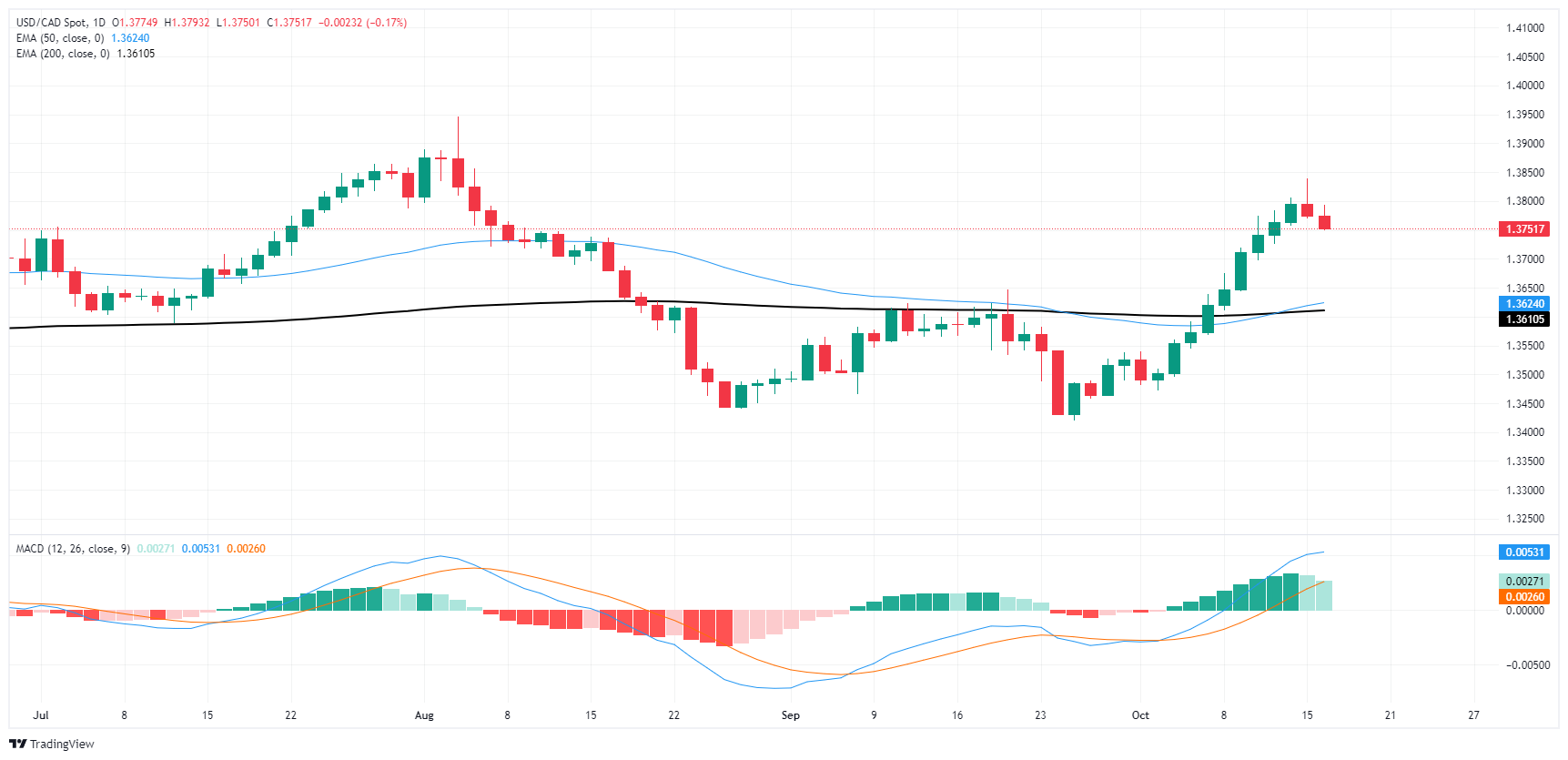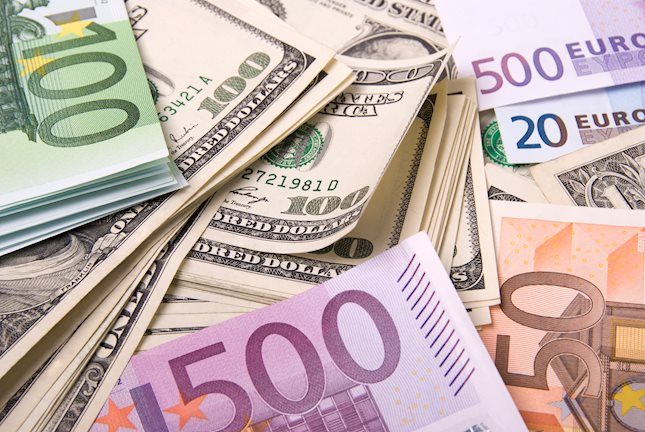- The Canadian Dollar has found a brief recovery after steady multi-week declines.
- Canada remains light on the economic calendar until next week’s BoC rate call.
- The BoC is widely expected to trim interest rates by a further 50 bps, decaying the CAD.
The Canadian Dollar (CAD) pared near-term losses on Wednesday, but not nearly enough to spark a fresh bull run. Markets are likely taking a breather after pummeling the CAD for nearly three straight weeks. The Loonie has shed over 3% against the Greenback since hitting a recent peak against the US Dollar in the bottom half of September.
Daily digest market movers
- The Canadian Dollar recovered some lost ground against the US Dollar, but still remains at the bottom of a long slide.
- The Bank of Canada (BoC) is widely expected to trim interest rates by 50 bps next week, leaving the CAD with little support heading into the rate call window.
- Canadian Consumer Price Index (CPI) inflation figures did little to bolster Loonie investor confidence this week, with a sharp drawdown in headline inflation but an uptick in core BoC-measured inflation.
- Canadian Housing Starts rose in September on a seasonally-adjusted basis to 223.8K from the previous 217.4K, but missed the forecast 237.5K.
- Canadian Manufacturing Sales in August beat expectations, but still contracted by 1.3% compared to the previous 1.4% upswing. Markets expected a print of -1.5% or worse.
Canadian Dollar price forecast
The USD/CAD daily chart shows the pair is losing some steam after a strong rally that propelled it above the key resistance of 1.3750. The pair briefly touched the 1.3800 mark, but recent price action indicates a minor pullback, suggesting that the bulls might be taking a pause. However, the price remains well above the 50-day EMA at 1.3624 and the 200-day EMA at 1.3610, signaling that the overall bullish trend remains intact for now. A close below these moving averages could signal a deeper retracement, but as long as USD/CAD holds above these levels, the bullish momentum is likely to continue.
The MACD indicator remains in positive territory, with the MACD line still above the signal line, but the histogram is showing signs of flattening out. This could suggest that the bullish momentum is waning, and traders should be cautious of a potential consolidation or minor pullback in the near term. A clear break above 1.3800 would be needed to confirm further upside, while a drop below the 1.3650 level could invite fresh selling pressure. Traders will be watching closely for any fundamental catalysts that could push the pair decisively in either direction.
USD/CAD daily chart
Canadian Dollar FAQs
The key factors driving the Canadian Dollar (CAD) are the level of interest rates set by the Bank of Canada (BoC), the price of Oil, Canada’s largest export, the health of its economy, inflation and the Trade Balance, which is the difference between the value of Canada’s exports versus its imports. Other factors include market sentiment – whether investors are taking on more risky assets (risk-on) or seeking safe-havens (risk-off) – with risk-on being CAD-positive. As its largest trading partner, the health of the US economy is also a key factor influencing the Canadian Dollar.
The Bank of Canada (BoC) has a significant influence on the Canadian Dollar by setting the level of interest rates that banks can lend to one another. This influences the level of interest rates for everyone. The main goal of the BoC is to maintain inflation at 1-3% by adjusting interest rates up or down. Relatively higher interest rates tend to be positive for the CAD. The Bank of Canada can also use quantitative easing and tightening to influence credit conditions, with the former CAD-negative and the latter CAD-positive.
The price of Oil is a key factor impacting the value of the Canadian Dollar. Petroleum is Canada’s biggest export, so Oil price tends to have an immediate impact on the CAD value. Generally, if Oil price rises CAD also goes up, as aggregate demand for the currency increases. The opposite is the case if the price of Oil falls. Higher Oil prices also tend to result in a greater likelihood of a positive Trade Balance, which is also supportive of the CAD.
While inflation had always traditionally been thought of as a negative factor for a currency since it lowers the value of money, the opposite has actually been the case in modern times with the relaxation of cross-border capital controls. Higher inflation tends to lead central banks to put up interest rates which attracts more capital inflows from global investors seeking a lucrative place to keep their money. This increases demand for the local currency, which in Canada’s case is the Canadian Dollar.
Macroeconomic data releases gauge the health of the economy and can have an impact on the Canadian Dollar. Indicators such as GDP, Manufacturing and Services PMIs, employment, and consumer sentiment surveys can all influence the direction of the CAD. A strong economy is good for the Canadian Dollar. Not only does it attract more foreign investment but it may encourage the Bank of Canada to put up interest rates, leading to a stronger currency. If economic data is weak, however, the CAD is likely to fall.
Information on these pages contains forward-looking statements that involve risks and uncertainties. Markets and instruments profiled on this page are for informational purposes only and should not in any way come across as a recommendation to buy or sell in these assets. You should do your own thorough research before making any investment decisions. FXStreet does not in any way guarantee that this information is free from mistakes, errors, or material misstatements. It also does not guarantee that this information is of a timely nature. Investing in Open Markets involves a great deal of risk, including the loss of all or a portion of your investment, as well as emotional distress. All risks, losses and costs associated with investing, including total loss of principal, are your responsibility. The views and opinions expressed in this article are those of the authors and do not necessarily reflect the official policy or position of FXStreet nor its advertisers. The author will not be held responsible for information that is found at the end of links posted on this page.
If not otherwise explicitly mentioned in the body of the article, at the time of writing, the author has no position in any stock mentioned in this article and no business relationship with any company mentioned. The author has not received compensation for writing this article, other than from FXStreet.
FXStreet and the author do not provide personalized recommendations. The author makes no representations as to the accuracy, completeness, or suitability of this information. FXStreet and the author will not be liable for any errors, omissions or any losses, injuries or damages arising from this information and its display or use. Errors and omissions excepted.
The author and FXStreet are not registered investment advisors and nothing in this article is intended to be investment advice.
Recommended content
Editors’ Picks

EUR/USD extends downside to near 1.0850, with all eyes on ECB rate decision
The EUR/USD pair extends its decline to near 1.0850 during the early Asian session on Thursday. The further upside of the Greenback exerts some selling pressure on the major pair. Investors will closely monitor the European Central Bank monetary policy meeting, which is expected to lower interest rates again on Thursday.

GBP/USD seems vulnerable below 1.3000, its lowest level since August 20
GBP/USD consolidates Wednesday’s softer UK CPI-inspired fall to over a two-month low. Bets for a BoE rate cut in November weigh on the GBP and the major amid a bullish USD. Hopes for a less aggressive Fed policy easing favor the USD bulls ahead of the US data.

Gold looks to $2,700 after Wednesday’s close above $2,670
Gold price is consolidating gains near record highs in Asian trading on Thursday, trading in the green for the third day in a row. Gold buyers now look to the US Retail Sales data for the next push higher.

ECB to cut rates by 25bp, any sign of worry about growth outlook could see faster rate cuts
Markets are more-or-less fully pricing in a 25 basis point cut this week, which means that the decision itself is unlikely to have any real impact on the common currency. Attention will be on the signalling within the bank’s communications.

Another unconvincing policy briefing fails to inspire confidence
Chinese authorities are playing the long game, trying to keep investors focused on the bigger picture, multiple stimulus measures spread out over time, with a bit of subtle bid support from state-backed institutions.

Best Forex Brokers with Low Spreads
VERIFIED Low spreads are crucial for reducing trading costs. Explore top Forex brokers offering competitive spreads and high leverage. Compare options for EUR/USD, GBP/USD, USD/JPY, and Gold.